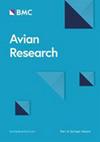人类足迹下内蒙古草原鸟类繁殖的性状介导反应及共现模式
IF 1.7
2区 生物学
Q1 ORNITHOLOGY
引用次数: 0
摘要
草原是世界上最受威胁的生态系统之一,草原鸟类面临着人类活动越来越大的风险。本文研究了人类活动对亚洲生物多样性热点地区内蒙古草原繁殖鸟类分布和群落结构的影响。综合物种发生数据、功能特征和人类足迹指数(HFI),在完整草原到城市化地区的梯度上进行标准化点数调查。利用广义线性模型(GLMs)和条件随机场(CRFs),我们评估了性状-环境相互作用和物种关联的变化。结果表明,高fi对鸟类群落有显著影响。栖息地专家,如蒙古云雀(Melanocorypha mongolica),表现出消极的反应,而像欧亚树雀(Passer montanus)这样的通才在受干扰的地区茁壮成长。基于性状的分析表明,体型较大和特定饮食的物种与HFI呈负相关,而与人类改造栖息地相关的物种则表现出强烈的正相关。在人类足迹高的地区,共生网络变得更加两极化:专家面临着激烈的竞争,而具有积极HFI反应的物种形成了更强的积极联系。CRF模型表明,人类活动重构了物种间的相互作用,有利于通才,简化了群落动态。这些发现强调了人类影响的双重作用,在支持某些物种的同时威胁专家,潜在地推动生物同质化。我们的研究强调了保护脆弱物种和管理那些在人类改变的环境中茁壮成长的物种的保护策略的必要性。通过将特征和相互作用与人类影响联系起来,本研究为识别濒危物种和指导人类世的保护提供了一个框架。本文章由计算机程序翻译,如有差异,请以英文原文为准。
Trait-mediated responses and co-occurrence patterns of breeding steppe birds under human footprint in Inner Mongolia
Grasslands are among the world's most threatened ecosystems, and steppe birds face increasing risks from human activities. This study investigates how human impacts affect the distribution and community structure of breeding steppe birds in Inner Mongolia, a biodiversity hotspot in Asia. We conducted standardized point-count surveys across a gradient from intact grasslands to urbanized areas, integrating species occurrence data, functional traits and the Human Footprint Index (HFI). Using Generalized Linear Models (GLMs) and Conditional Random Fields (CRFs), we assessed trait-environment interactions and shifts in species associations. Our results indicate that the HFI significantly affects bird communities. Habitat specialists, such as Mongolian Lark (Melanocorypha mongolica), showed negative responses, whereas generalists like Eurasian Tree Sparrow (Passer montanus) thrived in disturbed areas. Trait-based analysis showed that species with larger body mass and specialized diets were negatively associated with HFI, whereas those linked to human-modified habitats exhibiting strong positive associations. In areas with high human footprint, co-occurrence networks grew more polarized: specialists faced intensified competition, while species with positive HFI responses formed stronger positive associations. CRF models indicated that human activities restructure species interactions, favoring generalists and simplifying community dynamics. These findings highlight the dual role of human impact in supporting some species while threatening specialists, potentially driving biotic homogenization. Our study emphasizes the need for conservation strategies that protect vulnerable species and manage those that thrive in human-altered environments. By linking traits and interactions to human impacts, this study provides a framework for identifying at-risk species and guiding conservation in the Anthropocene.
求助全文
通过发布文献求助,成功后即可免费获取论文全文。
去求助
来源期刊

Avian Research
ORNITHOLOGY-
CiteScore
2.90
自引率
16.70%
发文量
456
审稿时长
46 days
期刊介绍:
Avian Research is an open access, peer-reviewed journal publishing high quality research and review articles on all aspects of ornithology from all over the world. It aims to report the latest and most significant progress in ornithology and to encourage exchange of ideas among international ornithologists. As an open access journal, Avian Research provides a unique opportunity to publish high quality contents that will be internationally accessible to any reader at no cost.
 求助内容:
求助内容: 应助结果提醒方式:
应助结果提醒方式:


